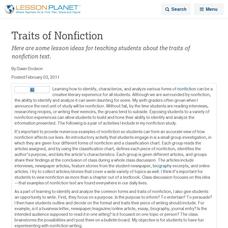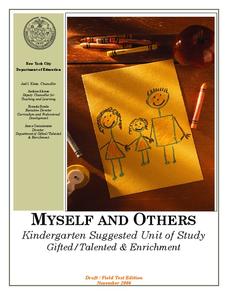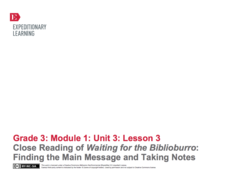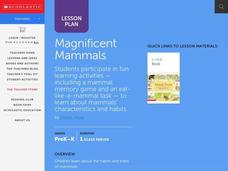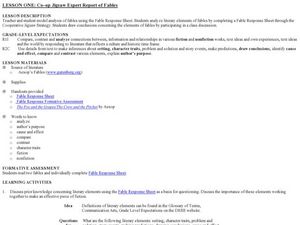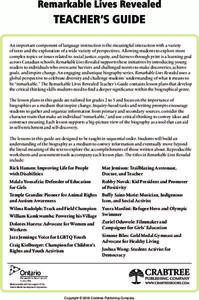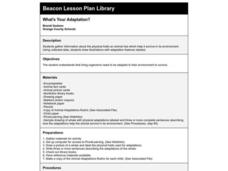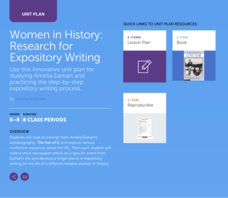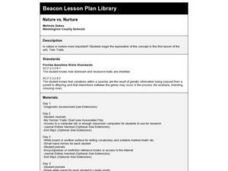Curated OER
Traits of Nonfiction
Here are some lesson ideas for teaching students about the traits of nonfiction text.
2012 Teaching Resources
Analyzing Character Traits
Character analysis becomes easy with a 24-page packet packed with mini-lessons, graphic organizers, and activities. A must-have for your curriculum library.
New York City Department of Education
Myself and Others
Self reflection is an important skill to reinforce in our children, and it's especially helpful to help them realize who they are in the context of their environment. A collection of lessons about self image and community encourage...
Curated OER
Fiction vs. Nonfiction
Young scholars explore fiction and nonfiction writing. They identify the elements of fiction in a short story and identify the criteria necessary in a nonfiction piece. Students distinguish the author's purpose in an expository text,...
EngageNY
Close Reading of Waiting for the Biblioburro: Finding the Main Message and Taking Notes
Expose your class to Waiting for the Biblioburro, narrative nonfiction that will act as the bridge between ficiton and informational texts to come. Class members do a close reading of the text, looking at excerpts instead of the whole...
Scholastic
Comprehension During Independent Reading
Ideal for a language arts class, literary unit, or independent reading assignment, a set of reading worksheets address a wide array of skills. From poetic elements to nonfiction text features, you can surely find a valuable resource in...
PBS
Reading Adventure Pack: Heroes
Three creative activities follow reading a fiction and nonfiction book about heroes. Scholars build hero action figures out of clay for make-believe play, explain in written form how they show bravery, kindness, patience, thoughtfulness,...
Curated OER
Nonfiction Genre Mini-Unit: Persuasive Writing
Should primary graders have their own computers? Should animals be kept in captivity? Young writers learn how to develop and support a claim in this short unit on persuasive writing.
Curated OER
Check Comprehension and Apply Writing
Elementary schoolers practice the skill of non-fiction writing. They study aspects of the famous Leaning Tower of Pisa, and write an essay which describes the tower and it's fascinating history. The article about the tower is included in...
Curated OER
Magnificent Mammals
Students study the habits, traits, and characteristics of mammals. They look at animal tracks that are taped around the room, and at pictures of baby and adult mammals. Next, they determine how mammals move and eat, and look at their...
Curated OER
Symbols and the Choices we Make
Upper elementary and middle schoolers recognize symbols that influence the choices that we make consciously or unconsciously in everyday life. They look at the symbols and choices that others make. They identify and apply knowledge of...
Curated OER
Cooperative Jigsaw Expert Report of Fables
Pupils research literary elements of fables. In this literature instructional activity, students analyze literary elements of fables. Pupils work collaboratively using a jigsaw strategy to analyze literary elements.
Crabtree Publishing
Remarkable Lives Revealed
Six lessons make up a unit all about biographies. Scholars read about a remarkable life while taking notes and identifying characteristics of the biographical genre. Readers examine the tale's obstacles, accomplishments, and sequence of...
Curated OER
What's Your Adaptation?
Second graders gather information about the physical traits an animal has which help it survive in its environment. Using collected data, 2nd graders draw illustrations with adaptation features labeled.
Curated OER
Character Scrapbook Teacher's Guide
Students analyze a book's characters and create a scrapbook to print and save. In this on line interactive characterization lesson plan, students identify character traits and gain a deeper understanding of a book's characters.
Curated OER
Women in History: Research for Expository Writing
After reading an excerpt from Amelia Earhart's autobiography, The Fun of It, learners explore various nonfiction resources about her life and write a short newspaper article on a specific event. They then develop a longer piece of...
Curated OER
End-of-Year Practice Test (Grade 4 ELA/Literacy)
The time has come to find out what your fourth grade readers have learned after another year of hard work. This Common Core-designed practice assessment provides two reading passages, one narrative and one expository, that children must...
Curated OER
LPS Nonfiction and Research Follow-Up CRT Project
Students read different types of literature in a group setting. They discuss the related themes and research them. They create a PowerPoint presentation on the information they have collected.
Curated OER
I Am What I Think I Am!
Students study conative and cognitive strengths through characters in literature. In this conative and cognitive strength lesson, students read about a favorite character or historical person. They make a chart of the difficulties the...
Curated OER
Nature vs. Nurture
Eighth graders investigate the concept of nature versus nurture in human development through this series of lessons.
Curated OER
Freckle Juice
Working in groups of four, the students will use the computer to draw an imaginary potion that will cure other children their age from physical traits (they can not control) including all ingredients and one text box.
Curated OER
"O Captain! My Captain!"
Who was Walt Whitman, and what link does he have to president Abraham Lincoln? After Lincoln's assassination, Whitman wrote "O Captain! My Captain!" This poem and "When Lilacs Last in the Dooryard Bloom'd" are the focus of exercises...
Curated OER
Drama Terms Notes
Comedy, tragedy, act, scene, prop. do you want to review important drama terms? Actors record the term next to its definition on a worksheet that could be used individually or as a group activity. A link to a corresponding PowerPoint...
Curated OER
We Like to Imagine - Animals
Students describe a pretend animal. They read "The After School Monster." Students read other books and discuss whether or not the characters are real. Students make a drawing of a pretend animal and of a real animal. They make up a...


